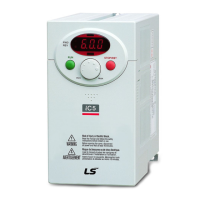8. Troubleshooting and Maintenance
Cause Remedy
Line voltage is too high. Check whether line voltage
Low
voltage
Line voltage is low.
Load larger than line capacity is
connected to line (ex: welding
machine, motor with high starting
current connected to the
commercial line).
Faulty magnetic switch at the
input side of the inverter.
Check whether line voltage is
below its rating.
Check the incoming AC line.
Adjust the line capacity
corresponding to the load.
Change a magnetic switch.
Electronic
thermal
Motor has overheated.
Load is greater than inverter
rating.
ETH level is set too low.
Inverter capacity is incorrectly
selected.
Inverter has been operated at
low speed for too long.
Reduce load weight and
operating duty.
Change inverter with higher
capacity.
Adjust ETH level to an
appropriate level.
Select correct inverter capacity.
Install a cooling fan with a
External
fault A
contact
The terminal which is set to “18
(External fault-A)” or “19 (External
fault-B)” in I20-I24 in I/O group is
ON.
Eliminate the cause of fault at
circuit connected to external fault
terminal or cause of external
fault input.
External
fault B
contact
Operating
method
when the
frequency
command
No frequency command is
applied to V1 and I.
Check the wiring of V1 and I and
frequency reference level.
Parameter save error Hardware fault
Contact your local LSIS sales
representative.

